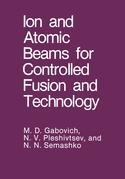Description
Ion and Atomic Beams for Controlled Fusion and Technology, Softcover reprint of the original 1st ed. 1989
Language: English
Publication date: 04-2012
242 p. · 17.8x25.4 cm · Paperback
242 p. · 17.8x25.4 cm · Paperback
Description
/li>Contents
/li>
A beam of ions in the fonn of "canal rays" was first observed in 1886 by E. Goldstein. The first ion source was invented by J. J. Thomson in 1910. This ion source became the basis for the first widespread application of ion sources in mass spectrographs and mass spectrometers. The second important application of ion sources is ion accelerators, which since the beginning of the 1930s have been employed in research on nuclear reactions and are now used in industry and medicine. A third application of ion sources is in systems for isotope separation and re search on the interaction of atomic particles with solids (1940s). The result of this research and development is the use of ion sources in semiconductor doping, decontamination of surfaces, and micromachining of surfaces (1960s and' 1970s), which is a fourth area of applications for ion sources. The heating of plasmas in magnetic confinement devices to thennonuclear temperatures (100-1000 MK) with the aid of megawatt beams of hydrogen and deuterium ions and atoms has become a fifth promising area of application for ion sources which can produce ion beams with steady-state currents of up to 100 A. Finally, experimental and industrial research are under way on the alloying of metals and the fabrication of coatings which greatly improve the physical and chemical properties of metals. These coatings can increase the hardness, high temperature corrosion resistance, and wear resistance of metals, and can enhance or reduce friction, etc.
1. Ion Sources, Plasma Emitters, and the Primary Formation of Ion Beams.- 1.1. Plasma ion sources and their major parameters.- 1.2. Plasma emitters of positive ions.- 1.3. Formation of ion beams. Plasma focusing.- 2. Focusing and Transport of Ion Beams.- 2.1. Propagation of nonrelativistic single-component charged-particle beams.- 2.2. Gas compensation of stable positive or negative ion beams.- 2.3. Spreading of compensated positive ion beams and its effect on focusing.- 2.4. The effect of the self-magnetic field of a compensated ion beam on beam transport.- 2.5. Synthesized beams.- 2.6. Collective processes in ion-beam plasmas and their effect on transport of compensated beams.- 2.7. Compensation of fluctuating ion beams and ion clusters (dynamic decompensation of ion beams).- 2.8. Plasma-optical lenses and transport of compensated ion beams.- 3. High-Current Ion Sources and Fast Atom Injectors for Thermonuclear Experiments.- 3.1. General information.- 3.2. Positive-ion-based injectors.- 3.3. Positive ion sources.- 3.4. Ion-optical system and neutralizer.- Charter 4. Mechanisms and Theory of Ion Sputtering of Metals.- 4.1. Ion sputtering and ion implantation in metals and the problem of improving the properties of metal surfaces.- 4.2. Rate of ion (cathode) sputtering.- 4.3. Dependence of the sputtering yield on the ion energy.- 4.4. The theory of sputtering by ion bombardment in the linear range of atomic collision cascades.- 4.5. Peak sputtering yields in the linear range of atomic collision cascades.- 4.6. Nonlinear effects in ion sputtering.- 4.7. Dependence of the sputtering yield on the angle of incidence of an ion at the target surface.- 4.8. Dependence of the sputtering yield on the ion dose and the residual oxygen and gas pressures.- 4.9. Dependence of sputtering yield on the cleavage plane of monocrystals and on the texture, roughness, and porosity of target surfaces.- 4.10. Sputtering yield dependence on target surface temperature.- 4.11. The parameters of the sputtering process and their effect on the sputtering yield.- 5. Ion Cleaning and Milling of Solid Surfaces.- 5.1. Advantages and features of ion-plasma technology.- 5.2. Ion decontamination of surfaces.- 5.3. Ion milling (etching).- 6. Ion Finishing and Exposure of Structure in Solid Surfaces.- 6.1. Ion grinding and polishing of metal and glass surfaces.- 6.2. Exposure of the surface structure of solids by ion bombardment.- 6.3. Topography and morphology of surfaces created by ion bombardment.- 7. Deposition of Films by Ion Sputtering.- 7.1. Thin film coatings and methods of producing them.- 7.2. Production of diamond and diamondlike films.- 7.3. Production of films of metals, alloys, oxides, borides, carbides, nitrides, silicides, sulfides, selenides, and tellurides by cathode sputtering.- 7.4. Ion sources for thin film sputter deposition.- 7.5. Comparison of films obtained by sputtering and other deposition techniques.- 7.6. Some applications of ion beams in thin film production.- 8. Ion Film Deposition and Plating of Surfaces.- 8.1. Optimum energy for ion deposition in films.- 8.2. Vapor condensation combined with ion bombardment (ion plating) of surfaces.- 8.3. Alternating ion—vapor film deposition.- 8.4. Vacuum—plasma film deposition (a method for condensation by ion bombardment).- 8.5. Production of textured tungsten layers in glow discharges.- 8.6. Film deposition by ionized clusters.- 8.7. A source of sputtered atoms for laser isotope separation (of uranium and other elements).- 9. Ion-Beam Welding, Microanalysis, and Micromachining of Solids with IonProbes.- 9.1. Ion-beam welding.- 9.2. Ion probes for microanalysis and micromachining of solids.- 9.3. Prospects for the use of submicron-sized ion beams.- References.
© 2024 LAVOISIER S.A.S.




